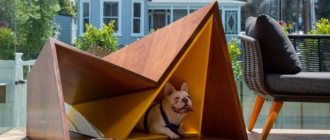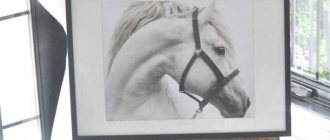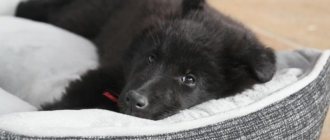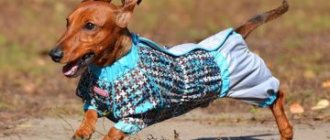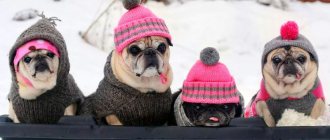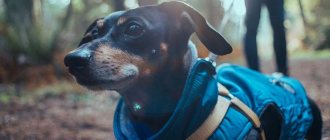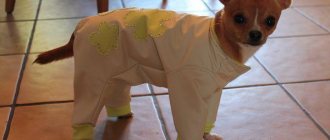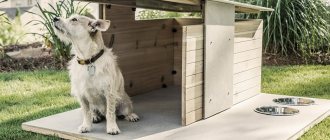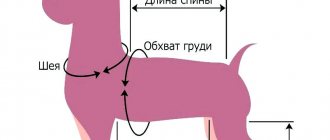Autumn is here and it's time to update the wardrobe of our favorite ponytails. And today I will sew two new blankets for my Jack. And at the same time I’ll show you how to easily sew a blanket for a dog with your own hands.
In general, in my opinion, a dog blanket is the most versatile and most comfortable model of clothing for pets. It does not restrict movement, is easy to put on and perfectly protects your furry friend from any weather. At least for my Jackusik, a blanket is, perhaps, the only thing he wears, if not with pleasure, then more or less tolerantly. Well, perhaps one of these “tolerant” accessories can also include a vest.
I’ve already sewed a blanket for Jackushka before. But that was a long time ago and, to be honest, my little dog has already grown out of it.
If you are a subscriber to our blog, then you have probably seen this master class on sewing a blanket. Well, if not, be sure to check it out. Maybe you'll like this style better.
Well, today we will sew TWO completely different blankets.
By the way, just recently I sewed another cool blanket model for Jack. This is a blanket with a hood. If you like this style, you can find a detailed video tutorial, pattern and materials consumption in the article: Autumn blanket with a hood for a dog.
Raincoat
One of them is this autumn raincoat blanket for a dog. It will be more closed than the blanket that I sewed before, and will better cover the entire body of the barbosie.
I spent a long time looking for a style that I liked. And I accidentally “stumbled upon” dog clothing manufacturers who have a lot of different cool things for our tailed friends. I liked exactly this model of blanket.
And I decided to repeat it.
Tips for choosing fabric
The choice of material for sewing overalls depends on the time of year and weather conditions of the region. The following requirements apply for a demi-season suit:
- “breathable” fabric so that the dog’s body is sufficiently ventilated;
- high-quality tailoring from durable material so that when touched by branches, the suit does not tear;
- water-repellent (so that the dog does not get wet in case of rain).
The best option for such overalls is membrane fabric. A thin layer of oilcloth is glued to this material, which does not allow the animal to get wet to the last thread . For winter, the overalls should preferably have a lining. When choosing a lining, opt for viscose or twill. It is preferable to sew summer versions of overalls from microfiber or raincoat fabric.
This is interesting: All about cats, cat and spring
Insulated winter blanket
And here is the second blanket for the pet. This is a warmer winter blanket for a dog.
I also saw this model on the Internet.
And I decided to sew the same cool insulated winter blanket for my Jack.
Outfit with a hood
In this section we will look at how to sew a dog costume with a hood. We will sew in the same way as described above. There is only one nuance in which we sew a tailored hood of a comfortable cut to the neck part.
For convenience, it is necessary to make it small.
It is recommended to insert an elastic band so that the hood can be tightened, so it definitely shouldn’t get in the way.
Let's look at the main points when sewing this component of the costume:
- The pattern is presented below. So, cut it out of paper. Apply to the fabric and trace. Cut out all the details;
- We place the visor parts face to face and machine stitch them;
- We turn the product inside out and process the part with an edge-to-edge seam along the curved side;
- Next, you need to sew the resulting visor to the hood itself.
The product is completely ready. Can be sewn to the neck part. As you can see, the visor tends to bend, thereby not interfering with the pet’s looking around. Models of suits with a hood are made mainly for toy terriers or chihuahuas.
Dog blanket pattern
I made the patterns for both blankets myself. I built it in my favorite way: on a grid. This is the simplest and most convenient way to create a clothing pattern for dogs.
The main size you need to measure to create the “mesh” is the length of your dog’s back from the neck (where the collar goes on) to the base of the tail. And then, based on this parameter, the side of the “grid” square is calculated. Divide the measured back length by 10 to obtain the side size of the square.
For example, your dog has a back length of 42cm. 42:10=4.2cm. Well, then we simply draw a “grid” of squares on a large blank sheet of paper, the side of each of which will be equal to 4.2 cm. After you have drawn the “grid”, simply transfer the pattern onto it.
In this video I tell you in great detail how to do this.
I hope after watching the video you understood the principle of constructing a grid and how to transfer a pattern to it.
Raincoat blanket pattern
And here is the pattern of our autumn blanket.
As a result, we should get such a comfortable autumn raincoat.
As I described earlier, the main size for creating a pattern is the length of your pet's back. But in order for the pattern to be most accurate, I advise you to take 3 more additional measurements:
- Neck circumference (it is needed in order not to make the distance along the chest too short, where the red arrow is indicated on the pattern).
- The distance between the paws (this will determine how correct you make the width of the “shelf”).
- Length of the belly (shelf). Well, with this size everything is clear. For boys it will be shorter, for girls a little longer.
In this photo I have outlined all these additional dimensions.
Winter blanket pattern
Pattern for an insulated winter blanket for your furry friend.
To sew this blanket we need only two measurements:
- The length of your pet's back.
- Chest circumference.
If everything is clear with the length of the back, it is the main size for creating a pattern. Then, thanks to the accurate measurement of the chest circumference, you can adjust the length of the lower (smooth line) of the back part on the pattern: make it smaller or lengthen it slightly.
Below (on the belly), the smooth protruding parts of the back part should “meet” with each other (as shown in the photo below).
After you have measured the length of the back, drawn a grid of “your” size, transferred the pattern to it, simply “adjust” the pattern taking into account all the additional measurements.
Taking measurements from the dog
Before you sew clothes for your pet, you need to take his measurements. These are the basic parameters of the body, which are then applied to the fabric. Moreover, the recommendations are valid for all breeds, from a small toy terrier to a large great dane.
During measurement, you need to study 2 rules in detail:
- The measuring tape should be pressed tightly against the body. Not just touching the fur, but tightening the skin, but without pressing.
- You need to add a few centimeters to the results obtained so that the dog can turn around calmly. This is especially true for breeds that cannot sit still.
After this, you just need to transfer the resulting replacements to the drawing and translate it into fabric.
So how do you take measurements from a dog? Need to measure:
- Back length, from neck to tail root;
- Volume of the sternum and cervical region;
- The volume of the waist belt together with the distance from the neck to the beginning of the hind legs;
- Girth of forelimbs;
- The length of the sleeve with the girth of the forelimb;
- Length of trousers;
- Length from genitals;
- The gap between the forelimbs and the gap between them and the hind limbs;
- Interaural distance;
- The volume of the head below, above, in front of the ears.
The tail is taken into account very rarely, for example, when sewing a designer jumpsuit. The only thing is that a hole or a small sleeve is cut out for the tail.
Dog clothes are usually sewn not only based on parameters. If the dog is a hunting breed, they need to move a lot, so things should always be looser for them.
Necessary materials
The choice of materials, of course, depends on the purpose of the blanket. If this is a summer raincoat, you can take membrane fabric and use regular lining fabric as a lining.
If you are sewing a winter blanket, you can use faux fur or fleece as a lining.
For a demi-season blanket for a dog, designed for a cool, slushy autumn or spring, I will need:
- Membrane or waterproof raincoat fabric.
- Backing stitch.
- Fastex plastic fastener.
- Adjustment plastic buckle
- 0.5 meters of belt sling.
- Regular elastic band (0.5 meters).
- Velcro (if necessary).
For an insulated winter blanket I took:
- Membrane or waterproof raincoat fabric (I used lining stitch on thin padding polyester).
- Fleece fabric for lining and hood.
- A rubber band approximately 3mm thick.
- Two latches.
- Velcro.
I will not describe step by step the entire process of making blankets. You can watch both master classes in video clips on our YouTube channel.
We take into account the nuances
- In addition to anatomical features, the gender of the animal should also be taken into account . The main difference between overalls for boys is the presence of a special cutout in the genital area. This cutout does not squeeze or rub. It is necessary for comfortable use of the overalls.
Pattern of overalls for a boy
- The choice of fabric depends on the season of use . Polyester is used for the autumn period. It protects well from rain and dirt. Bolognese material can be used for winter. Faux fur, fleece or plush are suitable as insulation.
- For long-haired breeds, it is recommended to use sliding fabric as a lining : satin, silk. Thanks to this, the wool will not roll or tangle. This move will ensure comfortable use of the overalls.
- When sewing winter clothes, sleeves and pants can be equipped with elastic bands . This will ensure that snow does not get under your clothes. The elastic band on the belly ensures a tighter fit to the body. Elastic bands that are pulled too tightly will cause discomfort when walking. Therefore, this detail should be approached very carefully.
- Various components can be used as regulators: buttons, zippers, Velcro, straps . The main thing is that they do not interfere with the pet’s movements. Velcro is not the best option in this situation: they quickly fail due to wool sticking to them.
The main requirement is the absence of discomfort when using the finished product. When sewing, carefully ensure that the overalls do not rub or squeeze the skin, do not interfere with the natural width of the step and do not restrict movement.
Conclusion
Overalls are an important element in a dog's wardrobe. It protects against harmful environmental influences, prevents the penetration of insects and serves as an effective decorative element. Sewing the product yourself will allow you to show maximum imagination and take into account all the features of your pet. This jumpsuit will be truly unique and as comfortable as possible.
Sewing techniques and subtleties
Many people mistakenly assume that it is much easier to sew clothes for a Chihuahua or Yorkie than for large breed dogs. In fact, rather the opposite. The pattern pieces are so small that much more time is wasted.
For your pet’s comfort, you should pay attention to the seams: they should be soft, without tangled threads or extra pieces of fabric. Clothes for dogs should not restrict movement or be tight. The collar and leash are worn under clothing, so you should take care of the holes for them. The genitals of males and females should be open, and attention should also be paid to this.
Tips for sewing clothes for dogs of different breeds
Good quality clothing directly depends on the correctness of the measurements taken and the making of the pattern. Even a novice seamstress can transfer the finished pattern onto fabric. You should pay attention to the accessories: tapes, zippers, fasteners, Velcro, elastic bands. They are found in almost every model of dog clothing.
Note! Dogs do not like clothing that is tight and restricts movement. Pants should not drag on the asphalt; the cuffs must be secured with elastic bands or laces.
Clothes for large breed dogs
How to sew a jumpsuit for a Yorkshire Terrier
Do-it-yourself clothes for a toy terrier are made either from ready-made detailed patterns or from your own design.
- Cut out finished patterns.
- Transfer the patterns to the fabric and secure with pins.
- Make seam allowances of approximately 1 cm and cut out all the pieces.
- Place the shelves next to each other and sweep away.
- Try on the dress, stitch.
- Fasten the shoulder seams and sew in the sleeves.
- Sew the remaining parts: collar, zipper.
- Decorate with sequins or other accessories.
DIY clothes for small dogs
Sewing clothes for small dogs can be a little more difficult, as there will be small details. But nevertheless, if everything is done correctly, the result will be worthwhile.
Dachshund blanket
Despite the fact that dachshunds are hunting dogs, they definitely need clothing. Especially in cold and rainy weather, the lower part of the body freezes very quickly. Therefore, a blanket is an ideal option that does not hinder movement. Even if your dog is not accustomed to wearing clothes, putting on this product will be very simple and quick.
Overalls for Yorkshire Terrier
To create a cute onesie for your dog, choose a suitable, high-quality material and prepare measurements. This type of clothing is best suited for cool weather.
Please note that the pattern consists of four parts. Their sizes will depend on the measurements of your terrier. Therefore, shoot them correctly. It is also worth noting that the jumpsuit has a zipper on the back. This option is perfect for this breed, since dogs are often very playful and sometimes even capricious.
Overalls for Chihuahua
Cute, playful Chihuahua dogs especially need appropriate clothing for the fall and winter season. Therefore, for this breed it is better to make several options. One of the most necessary things will be an insulated jumpsuit. If desired, you can even make a model with a hood. Thanks to this, the dog will be able to walk longer and will be protected from gusts of wind.
Warm reversible overalls for large breed dogs
One of the difficult questions is how to sew overalls for a dog. This clothing is more difficult to make than a jacket or vest. First you need to take measurements and create a pattern. Also choose the material and prepare the necessary tools.
Important! Before transferring the pattern to tracing paper, it needs to be increased based on the length of the back divided by 8.
How to cut a jumpsuit:
- Copies of parts are placed on thick paper.
- Each template is cut out and transferred to fabric.
- For convenience, the parts are secured with pins.
- Each outline is traced with chalk on the fabric and cut out, adding space for seams, about 1.5 cm.
- For beauty, you can use contrasting inserts.
- The contours of the pattern are transferred to the insulation and the necessary parts are cut out.
When all the parts are cut out, you can start assembling and sewing. This is done in this order:
- The outer and lining fabrics are folded together and the blanks are sewn together. In this case, it is better to first baste everything and then stitch it.
- All parts are sewn together in turn: first, the parts in the chest area are connected, then the front legs, side inserts and rear parts.
- A cord is placed in the side insert.
The jumpsuit can be decorated with a collar made of bright fabric. Thread elastic bands into it and add Velcro along the edges.
Knitted clothes for Yorkie
For needlewomen who know how and love to knit, you can offer the option of a knitted jumpsuit. It is very popular among owners of small and medium breeds. It doesn't take much time.
Let's consider the process of creating a knitted product for a Yorkshire terrier with the following dimensions: back length - 30 cm, chest circumference - 38 cm. For this knitting you need to purchase 65 grams of wool yarn and two pairs of knitting needles size 4 and 5.
The knitting pattern for a Yorkie suit is as follows:
- We begin to knit the back part of the product, casting on 80 chain stitches on the knitting needles and threading elastic bands for the neck into 10 of these loops.
- We knit the remaining loops first with regular satin stitch, and leave 20 loops for the elastic at the bottom of the overalls. As a result, you need to knit 50 rows.
- We start knitting the belly part, knitting 60 rows of 20 stitches in satin stitch.
- We begin to decrease the row 10 cm from the edge, which is equal to half the columns in the row.
- The loops should decrease symmetrically on both sides.
- We tie the remaining 10 columns with an elastic band for the pet’s neck.
- We sew together both parts of the overalls, leaving openings for the Yorkie's legs.
Stylish and warm knitted clothes for your pet are ready to try on!
Choosing fasteners
The well-chosen method of fastening determines whether putting on the costume will be comfortable for your pet or not. The following can be used as fasteners:
- rivets - they are convenient to fasten on costumes for small dogs;
- Velcro (easy to fasten, but additional fastenings are required);
- laces (used on outfits of small breeds and do not need to be sewn);
- elastic bands (very versatile and can be used for dogs of different sizes and weights).
Overalls for toy terrier
First of all, you need to find a pattern for small breed dogs or make it yourself by taking measurements from your pet. After this, cut out the details of the overalls from cardboard or thick paper.
- Transfer all patterns onto fabric.
- Leave space for seams, approximately 1.5 cm.
- Cut out all the details.
- Sew together.
It is toy terriers that suffer more from the winter cold, so it is better to use insulation for the winter period. This jumpsuit is perfect for corgis and other small breeds.
How to sew shoes for a dog: master class
The material for shoes is most often genuine leather. Especially for small breeds. In order to sew boots for a dog you will need the following materials:
Boots for dogs
Before you start sewing, you need to take measurements. After this, draw on the cardboard the sole of the desired size, the side part, the tongue and the nose. Cut the insulation and lining to the same size for the side and sole. Transfer patterns to fabric. Leave an allowance of 1 cm.
You need to sew a small dart on each spout. After this, you need to sew the tongues to them. The sole parts and side parts are sewn together. The side parts are attached to the toes and lastly the sole is sewn on. Accessories are added: Velcro or laces.
Handicraft lessons
It is not always possible to purchase an original vest or blanket for your pet. Also, postoperative blankets are not always available. However, if you have at least minimal skills in using a needle, sewing machine or crocheted knitting needles, there is always the opportunity to make (sew or knit) original clothes for your pet with your own hands.
How to sew a blanket with your own hands?
The lightest option for a blanket would be a regular cape of a rectangular or triangular shape. The rectangular blanket is secured around the neck with buttons or Velcro. In a triangular cape, two corners of the long side are passed between the dog’s paws and fixed on the back. You can also use buttons, Velcro or beautiful brooches. For convenience, you can make a loop at the base for the tail to hold the blanket tighter.
For those who love and know how to sew, you can complicate the design a little. And sew a full-fledged warm or summer vest, decorating it with a collar or hood. To make such a product, you first need to take measurements of your dog.
Sewing instructions
- DI – length from neck to tail;
- ОШ – volume of the neck at the base;
- OG - chest circumference;
- SHI is the width of the product (this is optional, you can make it long, up to the elbows, or short, covering only the back).
Using the measurements taken, we draw a pattern:
Pattern for sewing blankets
To ensure that the product does not gather in folds after trying on, we mark the places of the undercuts, and in order to hold it better, we sew a belt or an elastic strip with an elastic band inside from below, across the chest. A collar or hood can be sewn on to protect the neck or head.
For a winter cape, you should use warm fabrics: fleece, felt, cashmere, for a postoperative cape - chintz, cotton, poplin, calico. To make a waterproof one, you can purchase a regular cooling bed and use it to sew a dog vest for the summer using a pattern.
How to knit a vest for a dog?
If you know how to knit or crochet, you can knit a warm blanket for the autumn-winter period with your own hands. The easiest ones will be the rectangular and triangular versions with a hole already knitted for the tail.
If mastery of knitting needles or crochet allows you to knit more complex things, then you can knit a vest according to the following pattern, where:
- ОШ (neck circumference).
- DI (product length).
- Distance from the collar to the middle of the product.
- The width of the belly bar (an arbitrary value, varies depending on the size and breed of the dog).
- 2/3 OR.
- 2/3 OG (chest circumference).
- 1/3 OG +1-2 cm.
- The width of the collar (an arbitrary value, varies depending on the size and breed of the dog);
- Element for fastening 2-4 cm.
Pattern for a knitted blanket
Knitting instructions
We start knitting from the collar. We cast on the required number of loops (we do the calculation according to the pattern) equal to the OR. We knit the collar with a regular 2x2 or 1x1 elastic band or any other one you like. The width of the collar is arbitrary and depends on how large your dog is.
We close the number of loops equal to a third of the stitches and begin to knit the back. If you wish, you can knit it with a pattern; if not, then we knit a regular fabric with knit stitches, then the back can be decorated with embroidery. Along the edges of every second row, you need to make one yarn over to create a trapezoid.
When the width of the already knitted product becomes equal to two-thirds of the OG, we continue knitting without double crochets. 10-12 cm before the end of the product, we begin to decrease the loops, tying them in two at the end of every second row. If you want the blanket to be more rectangular, you don’t have to make any reduction.
The belt is knitted separately. It can be knitted with the same elastic band as the collar, or it can be knitted with a regular face fabric. As well as the fastener element numbered 9. The belt and fastener element are sewn on the sides of the product. To secure the belt and collar, you can choose buttons or Velcro.
Whatever breed the dog is, large or “pocket”, you always want your pet to be protected in any weather. And if the prices for “dog” clothes in stores are steep, you can always be creative and sew or knit a beautiful blanket with your own hands.
Summer and decorative
Some babies react so strongly to temperature fluctuations that even on a cool summer morning or evening they need clothing. Summer clothes are thin knitted or cotton sweaters, T-shirts, capes.
Summer clothing also includes special protective overalls. They are made of durable fabric, almost always light-colored, since their purpose is to protect the dog from bedbugs. Through dense tissue the parasite will not be able to bite the animal, and against a light background it is clearly visible. Such clothing should fit closely on the dog, the cuffs and collar should fit well to the skin. It has special wide cuffs and a neckline that prevent bedbugs from getting on the wool under clothing.
Decorative clothing is almost always designed for small breeds. Here the flight of imagination of designers and pet owners has no limits. Glamorous dresses, three-piece suits, jeans and plaid shirts, images of super heroes - owners dress up their dogs as anyone to highlight their pet’s individuality.
